EMI (electromagnetic interference) and RFI (radio-frequency interference) are disturbances generated by external sources that impact a cable assembly by degrading the assembly's performance or completely preventing it from functioning. These disturbances can cause problems ranging from an increase in error rates of the signal being transmitted through the assembly to total loss of any electronically readable signal.
EMI/RFI interference is generated by both natural and man-made sources. Potential sources of these disturbances could include:
| Potential Sources of EMI/RFI Interference | ||
|---|---|---|
| Automobile Ignition Systems | Mobile/Cordless Phones | Thunderstorms |
| Sun | Doorbell Transformers | Toaster Ovens |
| Electric Blankets | Heating Pads | Ultrasonic Pest Control Devices |
| Electric Bug Zappers | Touch Controlled Lamps | Wireless Devices |
| Bluetooth Devices | Baby Monitors | Microwave Ovens |
| Power Supplies | Ballast | Electric Motors |
By designing and building cable assemblies properly most, if not all, EMI/RFI can be eliminated. Below are issues and problems that need to be accounted for during the cable assembly design and production stages when EMI cable shielding needs to be addressed.
Issue 1: Bulk Cable with Inadequate Braid Coverage
Generally speaking, the higher the coverage of the braid shield on a cable the better. Typical coverage ranges from 65% to 95% with the higher coverage being able to protect against EMI/RFI to a much greater degree.
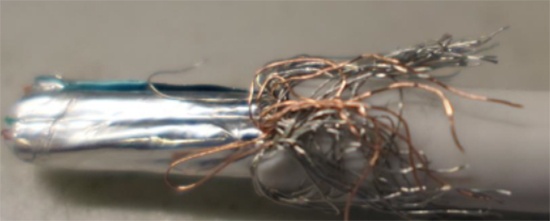
Bulk Cable Without Adequate Braid Coverage
Issue 2: Not Properly Preparing the Braid for Termination
If the braid of the cable is not of the correct coverage, the termination point of the cable to the connector will not allow for an efficient crimp. The connector backshell should include a ring that has an ID that matches the outer diameter (OD) of the outer cable jacket. The ring is slid onto the jacket of the cable and placed at the strip point of the jacket.
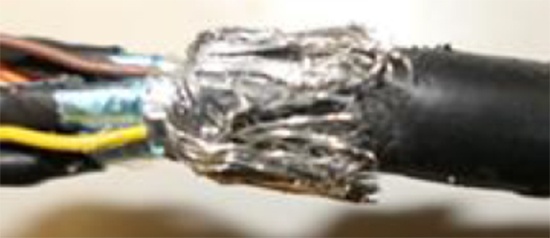
Braid Not Properly Prepared for Termination
The braid should be brought back over the ring and sandwiched between the ring and the shell when the shell is crimped. If the coverage of the braid isn’t sufficient for a 360° point of contact with the ring and shell when the shell is crimped, the crimp point will be inefficient from an EMI/RFI protection standpoint.
Issue 3: Not Sealing Seams Around the Backshell
The proper way to seal the connector backshell is to wrap the entire backshell in a metalized tape. The tape should be soldered to the backshell at the edges of the tape. Any joints where two edges of tape meet should be soldered as well.
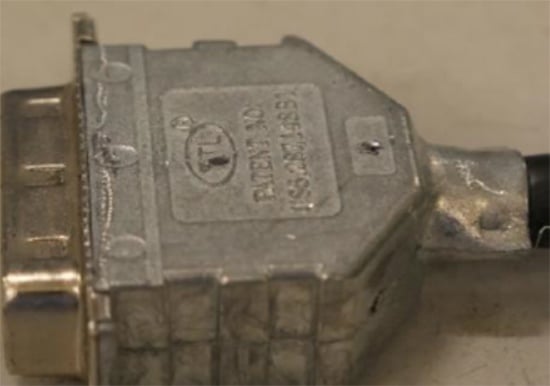
Connector Backshell with Seams not Properly Sealed
Issue 4: Not Sealing Crimp Area of The Backshell
As mentioned in Issue 3, the connector shell needs to be crimped onto the braid and cable jacket for a full 360°. In addition, the area at the crimp point needs to be sealed completely to provide the most efficient EMI/RFI protection possible. This area needs to be covered in metalized tape.
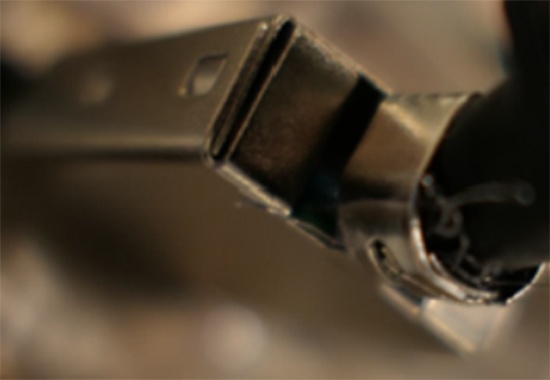
Connector Backshell with Improper Sealing of Crimp Area
Issue 5: Not Sealing the Wire Termination Area
Any shells need to extend from the insertion point of the connector to the contact point with the cable shield/cable jacket. Any gaps in the shell need to be either soldered together or wrapped in a metalized tape to completely seal the shell.
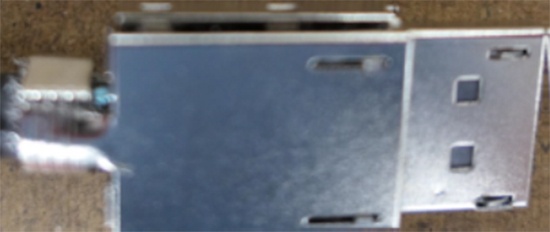
Unsealed Wire Termination Areas Can Create EMI
Summary
To optimize EMI cable shielding in your product, the cable assembly design needs to be built to account for all potential sources which can cause interference issues. Sealing shells completely and using cables with high shield coverage are ideal means of protection from EMI, as they allow for complete coverage from one end of the assembly to the other.
Key Takeaways
- Shield braid coverage is critical: Higher braid coverage (up to 95%) provides stronger protection against EMI/RFI, reducing noise and signal loss.
- Proper braid termination ensures continuity: The braid must achieve a 360° contact with the backshell ring and shell during crimping to maintain shielding integrity.
- Backshell seams must be sealed: Gaps or unsealed seams allow interference leakage; soldering or metalized tape should be applied to ensure a continuous conductive barrier.
- Crimp and termination areas require full sealing: Unsealed crimp zones and wire terminations can compromise shielding and become entry points for interference.
- Design must account for EMI/RFI from the start: Selecting cables with high shield coverage and ensuring complete sealing from end to end are essential to reliable performance.
















